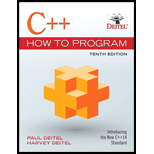
C++ How To Program Plus Mylab Programming With Pearson Etext -- Access Card Package (10th Edition)
10th Edition
ISBN: 9780134583006
Author: Deitel
Publisher: PEARSON
expand_more
expand_more
format_list_bulleted
Expert Solution & Answer
Trending nowThis is a popular solution!

Students have asked these similar questions
Information Security Risk and Vulnerability Assessment
1- Which TCP/IP protocol is used to convert the IP address to the Mac address? Explain 2-What popular switch feature allows you to create communication boundaries between systems connected to the switch3- what types of vulnerability directly related to the programmer of the software?4- Who ensures the entity implements appropriate security controls to protect an asset?
Please do not use AI and add refrence
Find the voltage V0 across the 4K resistor using the mesh method or nodal analysis. Note: I have already simulated it and the value it should give is -1.714V
Resolver por superposicion
Chapter 6 Solutions
C++ How To Program Plus Mylab Programming With Pearson Etext -- Access Card Package (10th Edition)
Ch. 6 - Show the value of x after each of the following...Ch. 6 - (Parking Charges) A parking garage charges a...Ch. 6 - Prob. 6.13ECh. 6 - (Rounding Numbers) Function floor can be used to...Ch. 6 - Prob. 6.15ECh. 6 - (Random Numbers) Write statement that assign...Ch. 6 - (Random Numbers) Write a single statement that...Ch. 6 - Prob. 6.18ECh. 6 - Prob. 6.19ECh. 6 - Prob. 6.20E
Ch. 6 - Prob. 6.21ECh. 6 - Prob. 6.22ECh. 6 - Prob. 6.23ECh. 6 - (Separating Digits) Write program segments that...Ch. 6 - (Calculating Number of Seconds) Write a function...Ch. 6 - (Celsius and Fahrenheit Temperature) Implement the...Ch. 6 - (Find the Minimum) Write a program that inputs...Ch. 6 - Prob. 6.28ECh. 6 - (Prime Numbers) An integer is said to be prime if...Ch. 6 - Prob. 6.30ECh. 6 - Prob. 6.31ECh. 6 - (Quality Points for Numeric Grades) Write a...Ch. 6 - Prob. 6.33ECh. 6 - (Guess-the-Number Game) Write a program that plays...Ch. 6 - (Guess-the-Number Game Modification) Modify the...Ch. 6 - Prob. 6.36ECh. 6 - Prob. 6.37ECh. 6 - Prob. 6.38ECh. 6 - Prob. 6.39ECh. 6 - Prob. 6.40ECh. 6 - Prob. 6.41ECh. 6 - Prob. 6.42ECh. 6 - Prob. 6.43ECh. 6 - Prob. 6.44ECh. 6 - (Math Library Functions) Write a program that...Ch. 6 - (Find the Error) Find the error in each of the...Ch. 6 - (Craps Game Modification) Modify the craps program...Ch. 6 - (Circle Area) Write a C++ program that prompts the...Ch. 6 - (pass-by-Value vs. Pass-by-Reference) Write a...Ch. 6 - (Unary Scope Resolution Operator) What’s the...Ch. 6 - (Function Templateminimum) Write a program that...Ch. 6 - Prob. 6.52ECh. 6 - (Find the Error) Determine whether the following...Ch. 6 - (C++ Random Numbers: Modified Craps Game) Modify...Ch. 6 - (C++ Scoped enum) Create a scoped enum named...Ch. 6 - (Function Prototype and Definitions) Explain the...Ch. 6 - Prob. 6.57MADCh. 6 - Prob. 6.58MADCh. 6 - (Computer-Assisted Instruction: Monitoring Student...Ch. 6 - (Computer-Assisted Instruction: Difficulty Levels)...Ch. 6 - (Computer-Assisted Instruction: Varying the Types...
Knowledge Booster
Similar questions
- Describe three (3) Multiplexing techniques common for fiber optic linksarrow_forwardCould you help me to know features of the following concepts: - commercial CA - memory integrity - WMI filterarrow_forwardBriefly describe the issues involved in using ATM technology in Local Area Networksarrow_forward
- For this question you will perform two levels of quicksort on an array containing these numbers: 59 41 61 73 43 57 50 13 96 88 42 77 27 95 32 89 In the first blank, enter the array contents after the top level partition. In the second blank, enter the array contents after one more partition of the left-hand subarray resulting from the first partition. In the third blank, enter the array contents after one more partition of the right-hand subarray resulting from the first partition. Print the numbers with a single space between them. Use the algorithm we covered in class, in which the first element of the subarray is the partition value. Question 1 options: Blank # 1 Blank # 2 Blank # 3arrow_forward1. Transform the E-R diagram into a set of relations. Country_of Agent ID Agent H Holds Is_Reponsible_for Consignment Number $ Value May Contain Consignment Transports Container Destination Ф R Goes Off Container Number Size Vessel Voyage Registry Vessel ID Voyage_ID Tonnagearrow_forwardI want to solve 13.2 using matlab please helparrow_forward
- a) Show a possible trace of the OSPF algorithm for computing the routing table in Router 2 forthis network.b) Show the messages used by RIP to compute routing tables.arrow_forwardusing r language to answer question 4 Question 4: Obtain a 95% standard normal bootstrap confidence interval, a 95% basic bootstrap confidence interval, and a percentile confidence interval for the ρb12 in Question 3.arrow_forwardusing r language to answer question 4. Question 4: Obtain a 95% standard normal bootstrap confidence interval, a 95% basic bootstrap confidence interval, and a percentile confidence interval for the ρb12 in Question 3.arrow_forward
arrow_back_ios
SEE MORE QUESTIONS
arrow_forward_ios
Recommended textbooks for you
 C++ Programming: From Problem Analysis to Program...Computer ScienceISBN:9781337102087Author:D. S. MalikPublisher:Cengage Learning
C++ Programming: From Problem Analysis to Program...Computer ScienceISBN:9781337102087Author:D. S. MalikPublisher:Cengage Learning C++ for Engineers and ScientistsComputer ScienceISBN:9781133187844Author:Bronson, Gary J.Publisher:Course Technology Ptr
C++ for Engineers and ScientistsComputer ScienceISBN:9781133187844Author:Bronson, Gary J.Publisher:Course Technology Ptr Microsoft Visual C#Computer ScienceISBN:9781337102100Author:Joyce, Farrell.Publisher:Cengage Learning,
Microsoft Visual C#Computer ScienceISBN:9781337102100Author:Joyce, Farrell.Publisher:Cengage Learning,

C++ Programming: From Problem Analysis to Program...
Computer Science
ISBN:9781337102087
Author:D. S. Malik
Publisher:Cengage Learning

C++ for Engineers and Scientists
Computer Science
ISBN:9781133187844
Author:Bronson, Gary J.
Publisher:Course Technology Ptr

Microsoft Visual C#
Computer Science
ISBN:9781337102100
Author:Joyce, Farrell.
Publisher:Cengage Learning,